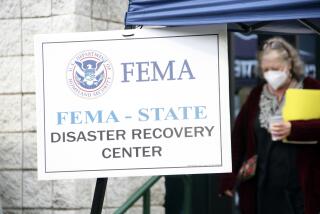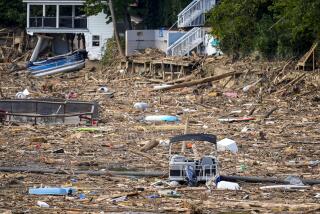Governor Irks Evacuees by Stalling Return
- Share via
MYRTLE BEACH, S.C. — Among many South Carolina coastal residents crammed into inland shelters, only one name on Friday was less popular than Hugo’s--that of their governor, Carroll A. Campbell Jr.
Early Friday, after the worst of the hurricane’s tempest had passed, Myrtle Beach Mayor Bob Grissom gave the go-ahead for residents to return to their homes, sparking massive defections from inland evacuation centers.
After evacuees thronged the highways bound for the coast, causing major traffic tie-ups, Campbell countermanded Grissom’s order.
Campbell was clearly concerned about the consequences of a sudden return to the devastated coastal towns. Power lines were down everywhere; trees blocked roads; bridges were suspect. And he wanted no possibility of looting, as had been reported in Charlestown.
“It’s going to be miraculous if we don’t have a heavy loss of life,” he said. “It is the worst storm, the worst disaster, I’ve ever seen anywhere.”
But residents, some of whom heard that it was not all that bad, were eager to return home and survey the damage. Instead, they were forced to turn back after waiting hours in traffic jams.
“We’re getting jerked around bad,” said John Douglas, a Myrtle Beach homeowner who had been back and forth to the roadblocks three times. “If Campbell hasn’t been here he doesn’t know.”
By 5 p.m. Friday, Campbell relented, allowing Myrtle Beach residents to return, but slapping a stiff 8 p.m.-to-dawn curfew on them.
The conflicting orders threw evacuees and the shelters that housed them into confusion, and tempers flared after a sleepless night spent in close quarters avoiding Hugo’s devastation.
“This is a power play,” said Charlie Harb, a Myrtle Beach resident leaving the shelter at Conway High School late Friday. “Our mayor should have the power and the right to tell us when it’s safe to come back.”
Nancy Anderson, manager of the Conway High School shelter, which housed as many as 4,000 Thursday night, agreed that the conflicting signals had worsened an already tense situation. One of the lessons learned from Hugo, Anderson said, is: “We need to have a clear understanding of who has the authority to give the word to go home.”
What concerned emergency managers most, however, is that Campbell’s refusal to let residents return home as soon as it was safe to do so may discourage them from leaving their homes to seek shelter in the next disaster.
“Next time I will stay home,” Douglas said.
More to Read
Sign up for Essential California
The most important California stories and recommendations in your inbox every morning.
You may occasionally receive promotional content from the Los Angeles Times.














